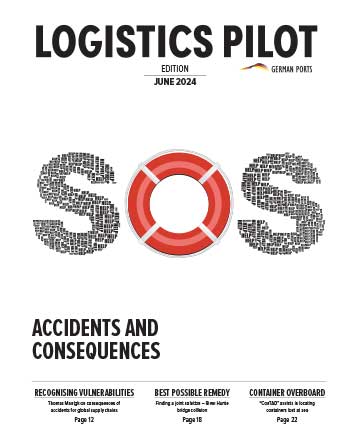The opening of Kühne + Nagel’s German headquarters will strengthen the Bremen location and at the same time continue the tradition of the seaport freight forwarding company founded there in 1890. Sustainability and the reinvention of the globally active logistics service provider are now the main focus.
Photos: Gabriele Tinscher
Kühne + Nagel International. “Now that German operations are once again being conducted from the banks of the Weser River, Bremen’s economic and logistics location is clearly being strengthened.” Ralf Miehe, head of the main branch, adds: “Bremen stands for logistics: The branch directly and indirectly employs about 70,000 people here, which is approximately 25 percent of the jobs in the federal state.”
Shipping is especially important for the location boasting Germany’s second largest port – and in particular for Kühne + Nagel’s sea freight division. This can also be seen in the wave-shaped façade of the new building, which is intended to reflect this maritime tradition. This architectural design not only inspires the honorary president and the head of the main branch office: “Be it customers, politics or associations: the building and its architecture are well received and serve as a new gateway for our city,” reports Miehe.
By contrast, the interior of the three building sections with their ten floors and a gross floor area of 13,500 square metres was conceived in an elegant but simple manner: Miehe points out that they “have consciously decided on a puristic design of the rooms – not out of cost considerations, but rather in keeping with Hanseatic sentiment.” For instance, no pictures are hanging on the office walls of the 725 employees, and personal decoration has also been kept to a minimum. Instead, there is now a chic bistro and a coffee lounge. When the weather is nice, employees can also enjoy the large roof terrace.
This is not the only place from where the view of the city is magnificent. The view from the conference room on the ninth floor, called Skylounge, is particularly impressive. Care was also taken to ensure that the offices receive plenty of natural light: Altogether there are 900 large windows that can also be opened.
Focusing on sustainability
The protection of resources was also an important factor: As part of its “Net Zero Carbon” programme, the logistics service provider has been climate-neutral since the beginning of the year in terms of Scope 1 and 2, which are factors that can be directly influenced such as buildings, warehouses and own vehicles.
Facts
established: 1890
Main areas of business: Sea freight, air freight, land transport, contract logistics and integrated logistics
German headquarters: Bremen
Employees: close to 82,000 worldwide at 13,000 locations in over 100 countries, 1,100 of whom work at the Bremen branch
Total net sales: nearly 21.1 billion Swiss francs, of which 7.5 billion Swiss francs are sea freight (2019) Sea freight transport volume: 4.9 million TEU (2019)
Moving to the new building has also brought with it another important change: In view of the fact that Bremen is now the location of the German headquarters, the management functions of the German ocean shipping business, among others, are now concentrated here. With a total of 600 employees, of whom about two thirds work in export and one third in import, this is the most important business area here and accounts for about 50 percent of sales. In comparison: Some 150 people work in land transport, 150 in contract logistics and 30 in air freight. Altogether, Kühne + Nagel employs about 1,100 people in Bremen, which is 375 more than the new building can accommodate. “We realised from the outset that we would not be able to accommodate everyone here due to the size of the building area,” Miehe points out.
This move also involves a transformation for all offices at the Bremen location. “The good old days of handshakes are a thing of the past. Instead, we now find ourselves in a completely new era, both technically and culturally,” the head of the main branch office reports. Consequently, a change is inevitable, from which the employees at all locations will certainly benefit. “It is precisely because we are 130 years old that we have to reinvent ourselves.” This does not, however, refer to reviewing business processes – which takes place continuously in any case. And even the practice of a virtually paperless office has long been part of everyday life. “We are talking about a new world of productivity in which everything is characterised by technology,” explains Miehe. Therefore, any process that still has mechanical components must be digitised or outsourced. “This is the only way to ensure positive qualitative and quantitative results for our customers.”
Even the method of operation has changed considerably. Miehe notes that this includes, for example, the independent organisation of working hours between the hours of 06:00 and 20:00, with a core working time. “In the end, in the world of key figures, the only thing that matters is that the targets are reached.” This flexibility is particularly appreciated by employees living outside Bremen and by single parents. The building also offers ten partially flexible workstations and four parent-child offices.
“We also have a project that deals with agile working methods,” reports Miehe. However, the focus is not on the decrease in hierarchical levels that goes along with this: “We already work with very flat hierarchies.” In any event, the door to the head of the house’s office on the ninth floor is always open to employees. There, Miehe not only likes to share his view of the Schlachte, but together with the employees he also takes pleasure in looking forward to the future in the new headquarters: “I wish for us to have plenty of fresh wind beneath our wings here.” (cb)
Most read
Logistics Pilot
The current print edition - request it now free of charge.





